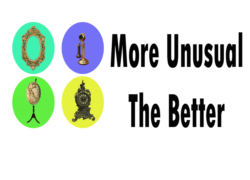Hi and welcome to our Show and Tell. We are showing off some of our fun items that we collected throughout the years. If you see something of interest and are in the USA please contact us. Then we can possibly list and reserve the item you’re interested in at our Etsy store for purchase. For pickup only items we can list and reserve the item at our Ebay store. We are not selling items through this website, it is for Show and Tell purposes only. Thank You!
Vintage Art Nouveau Footed Trinket Dish, Pin Tray, Card Receiver, Ring Display. Nice tray with Nouveau nude in dish holding a scroll dated 1907. Has 3 feet and sits well. Good condition for being 117 years old. Signed Schlick Budapest underside and attributing to Ignác Schlick. Found some fun reading on this famous historic ironworks company at the cool PestBuda and added a sliver at bottom of page.
Measurements are 7″ x 5 1/4″ and sits 3/4″ high. Nice weight at 9 1/2 oz. Feels heavy like bronze but could be brass. Nonmagnetic with heavy greening, verdigris, tarnishing, nice Patina and still looks great.
Made 1907. Cool Important Historic Tray!!
Check pictures for description and condition.
The factory he founded played an indispensable role in the development of the Hungarian capital, as he made the iron structures of many emblematic buildings: the dome of the Parliament, the Opera House and the Hungarian Academy of Arts and the Museum of Applied Arts, as well as the glass-iron facade curtain walls of the Nyugati (Western) and Keleti (Eastern) railway stations. The Deák statue in Széchenyi Square was also made in his foundry. Although Ignác Schlick may be known to a few, his work is often forgotten in the development of Budapest.
Ignác Schlick was born on 13 April 1821 in Pest. After secondary school and finishing his studies as a copper founder, he studied the art of iron founding in France, Switzerland, and Germany for seven years. After returning home, he opened an iron foundry in Víziváros and then in the industrialising Ferencváros. After that, he became the manager of the foundry of the Óbuda shipyard. A few years later, he reopened his iron foundry in Víziváros, on Fő Street, in 1860 and thus founded his own company.










